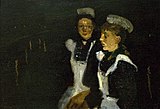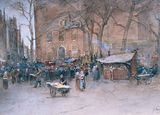Amsterdam impressionism
The Amsterdam Impressionism was a Dutch art movement of the late 19th century .
history
Amsterdam Impressionism is rooted in the Hague School and was mainly adopted by a young generation of artists in Amsterdam . The painters of both currents painted impressionistically , the two schools differed mainly in the choice of subjects : While the Hague painters preferred landscapes and sea representations and emphasized the atmospheric, the Amsterdam painters concentrated on realistic everyday life in Dutch cities.
George Hendrik Breitner , Isaac Israëls and Willem Witsen are considered to be important representatives of the Amsterdam Impressionists . You studied at the Rijksakademie van beeldende kunsten with lecturers who were less attached to traditional traditions. In 1882 they founded the “St. Lucas ”(the patron saint of painters) in order to promote the artistic subjects at the academy and the collegial relationships among the students. In addition, the members met weekly for art viewing and lectures.
In 1880, at the age of twenty, Breitner had come into contact with representatives of the Hague School, such as Jozef Israëls , Jacob Maris , Anton Mauve and others through the Pulchri Studio artists' association in The Hague . He worked in Willem Maris' studio in The Hague and one year later he helped Hendrik Willem Mesdag in Scheveningen to paint the famous panorama. In 1886, after two years of training with Fernand Cormon in Paris, he returned to the Netherlands and settled in Amsterdam. He broke away from the style of the Hague School and began painting Amsterdam city scenes and cityscapes. He worked with quick brushstrokes and tried to give an impression of life on the street with his artisans, housewives, dock workers, street dogs. His drawings often gave a gray, depressing picture of the streets of the capital. That is why he would later become known as the painter of “Impressionism noir”.
Other Amsterdam impressionists were Floris Hendrik Verster , Willem Bastiaan Tholen , Kees Heynsius , Willem de Zwart , Dirk van Haaren and Jan Toorop .
Major artists of this movement
A number of artists who belong to the 2nd generation of Dutch Impressionism are such names as
- Pieter Florentius Nicolaas Jacobus Arntzenius (1864-1925)
- Johan Braakensiek (1858–1940)
- Nicolaas Bastert (1854–1939)
- Cornelius de Bruin (1870-1940)
- George Hendrik Breitner (1857-1923)
- Dirk van Haaren (1878–1953)
- Kees Heynsius (1890–1981)
- Isaac Israëls (1865-1934)
- Hendrik Maarten Krabbé (1868–1931)
- Jacobus van Looy (1855-1930)
- Jan Thorn Prikker (1868–1932)
- Richard Roland Holst (1884–1956)
- Hobbe Smith (1862-1942)
- Willem Bastiaan Tholen (1860-1931)
- Johannes Theodorus Toorop (1858–1928)
- Floris Vester (1864-1925)
- Jan Hillebrand Wijsmuller (1855–1925)
- Willem Witsen (1860-1923)
- Willem Hendrik de Zwart (1862-1931)
Amsterdam Impressionist Gallery
Floris Arntzenius (1874/1925): Market with flower stalls, Rijksmuseum Amsterdam .
Amsterdamse Joffers as another movement in Amsterdam Impressionism
- Lizzy Ansingh (1875-1959)
- Jo Bauer-Stumpff (1873–1951)
- Ans van den Berg (1873–1942)
- Nelly Bodenheim (1874-1951)
- Marie van Regteren Altena (1868-1958)
- Jacoba Johanna (Coba) Ritsema (1876–1961)
- Suze Robertson (1855-1922)
- Thérèse Schwartze (1851-1918)
- Jacoba Surie (1879-1970)
- Betsy Westendorp-Osieck (1880–1968)
Other loose members were:
- Elsa van Doesenburg (1875–1957)
- Josepha Johanna Julia Marie Tepe (1884–1962)
Gallery of the Amsterdamse Joffers
Thérèse Schwartze (1885): Three girls from the orphanage in Amsterdam.
Bibliography
- The Schools of the Hague and Amsterdam Impressionists, 1850-1900 . Usher Art Gallery, Lincolnshire 1949.
- AW Hammacher: Amsterdam Impressionists en hun Kring. JM Meulenhoff, Amsterdam 1946.
- Wiepke Loos, Carpel van Tuyll van Serooskerken: Waarde Heer Allebé - Leven en werk van August Allebé (1838–1927). Wanders, 1988, ISBN 90-6630-124-4 .
- Sheila D. Muller: Dutch Art - An Encyclopedia. Routledge, 2013, ISBN 978-1-135-49574-9 .
- Johan H. van Eikeren: De Amsterdamse Joffers: Marie E. van Regteren Altena, Ans van den Berg, Jo Bauer-Stumpff, Nelly Bodenheim, Lizzy Ansingh, Coba Ritsema, Coba Surie, Betsi Westendorp-Osieck. FG Kroonder, 1947.
- Gerritsen-Kloppenburg, Mieke en Henriëtte Coppes: De kunst van het schutte bestaan: vijf schilderessen aan het begin van deze eeuw: Thérèse Schwartze, Betzy Rezora Berg, Jacoba van Heemskerck, Ans van den Berg, Betsy Osieck. Heerlen 1991.
- Ingrid Glorie: Juffers en Joffers: een eerbewijs aan vrouwen in de Schilderkunst. De Doelenpers, 2000, ISBN 90-70655-27-6 .
- Geurt Imanse: Van Gogh to Cobra: Dutch painting 1880–1950. Hatje, 1980, ISBN 3-7757-0160-5 .
- Norma Broude: Impressionism - An International Movement 1860-1920, DuMont Buchverlag, Cologne 1990, ISBN 3-8321-7454-0 .
- Jean Bouret: L'École de Barbizon et le paysage française au XIXe siècle. Neuchâtel 1972.
- Georges Pillement: Les Pré-Impressionistes. Train 1972, OCLC 473774777 .
- Karin Thomas: Blickpunkt der Moderne: A story from romanticism to today. Verlag M. DuMont, Cologne 2010, ISBN 978-3-8321-9333-1 .
Web links
- Entry in the Rijksmuseum Amsterdam (English)
- Entry Museum of Fine Arts, Boston (English)
- Art Directory entry about Jozef Israëls and Amsterdam Impressionism
Remarks
- ↑ Geurt Imanse: Van Gogh to Cobra: Dutch painting 1880–1950. Hatje, 1980, pp. 116, 279.
- ^ Sarah de Clercq: Cavalry and an elegant lady on a bridge, The Hague by George Hendrik Breitner . Christie's Specialist Selection, June 4, 2009.
- ^ Rijksakademie: History , website of the Rijksakademie on its history (Dutch, English). Retrieved December 29, 2014.
- ↑ Britta Bley: From the state to the nation: On the role of art in the development of a Dutch national consciousness in the long 19th century. LIT Verlag, Berlin / Hamburg / Münster 2004, ISBN 3-8258-7902-X , p. 115 (also available from google books)
- ↑ Geurt Imanse: Van Gogh to Cobra: Dutch painting 1880–1950. Hatje, 1980, p. 248.
- ↑ He is one of those artists who discovered photography as a means of expression for art.
- ↑ His Œvre ranges from Amsterdam Impressionism to the Hague School of the 2nd generation. The motifs from Amsterdam are more of the calm mood.










































